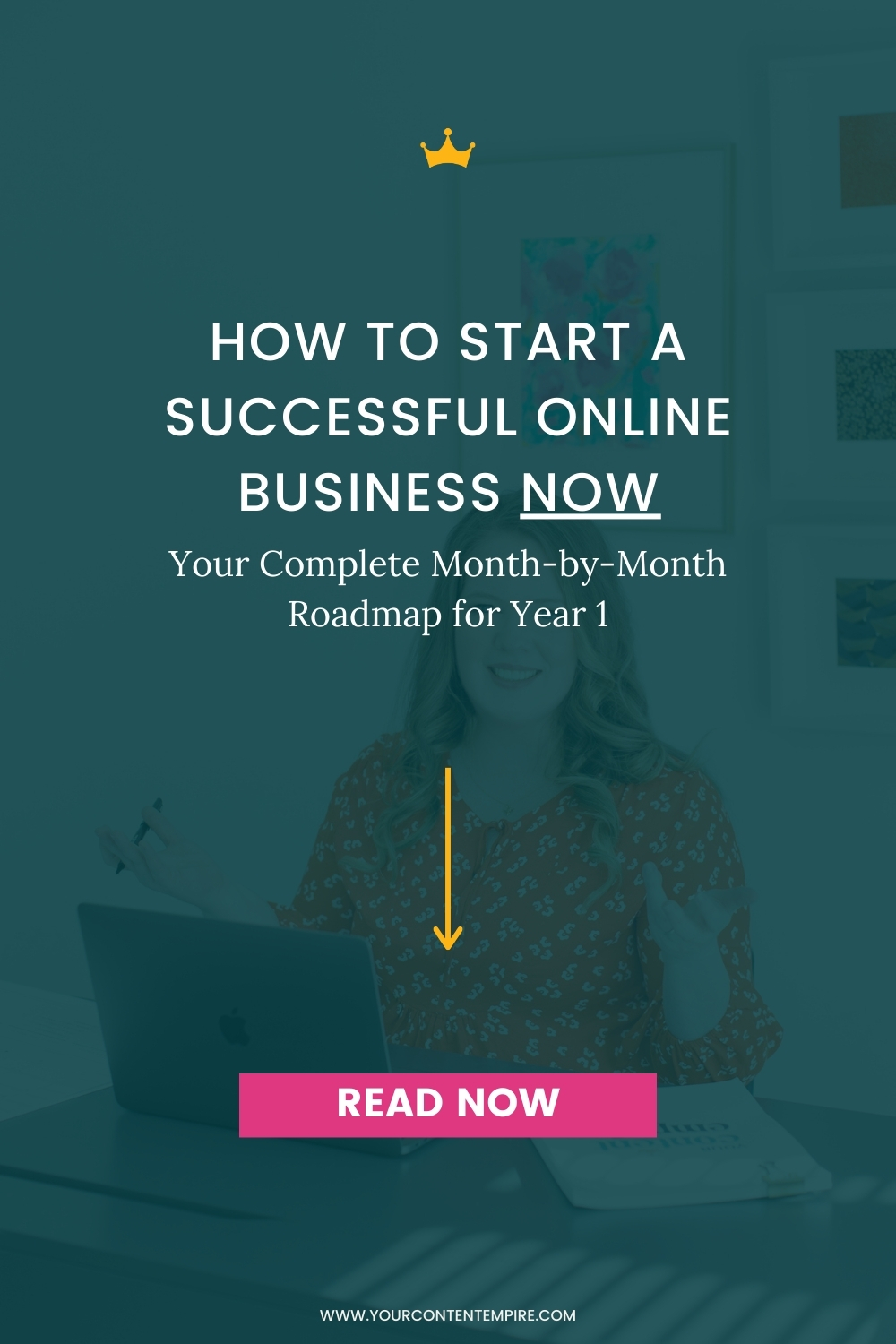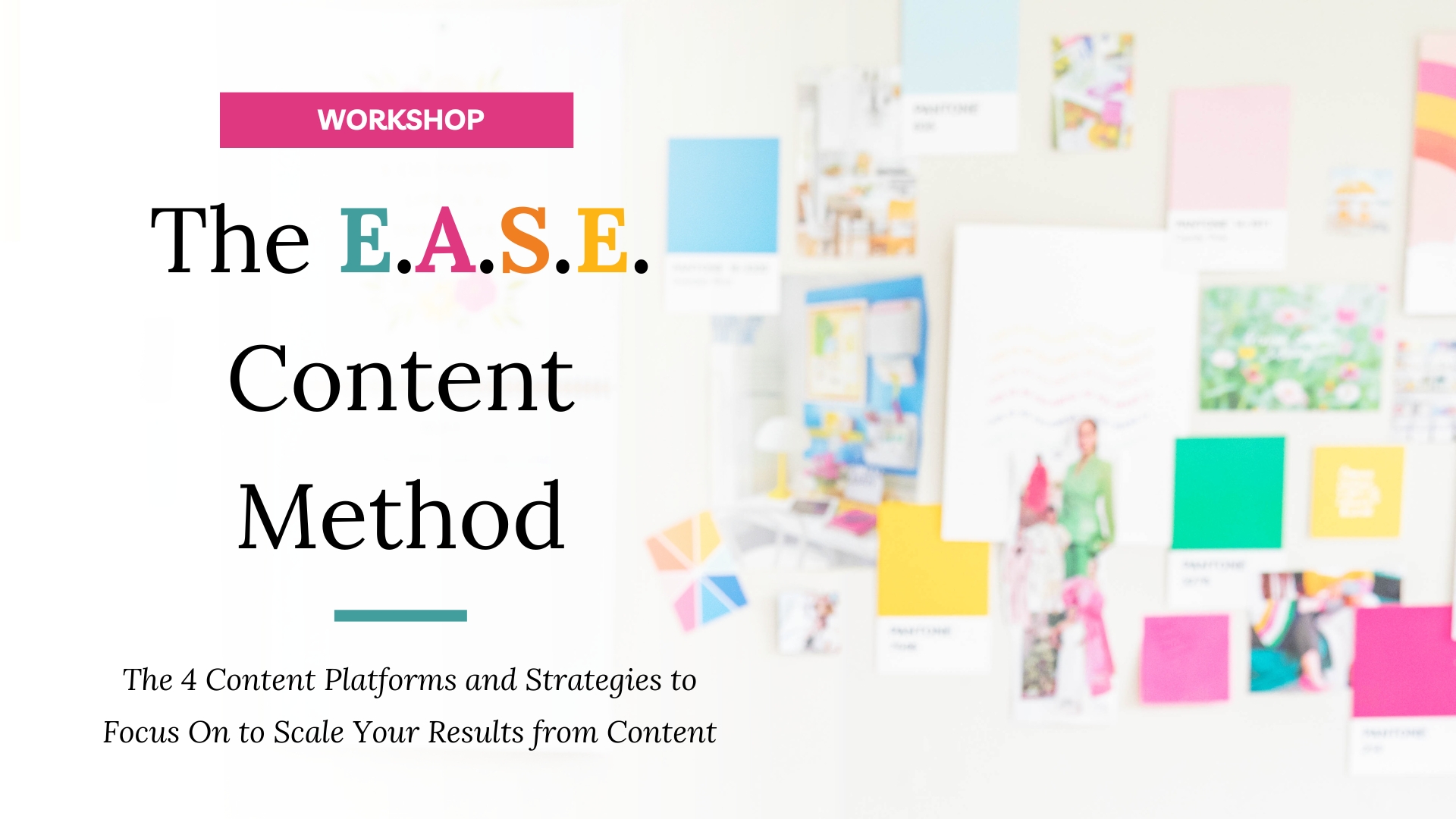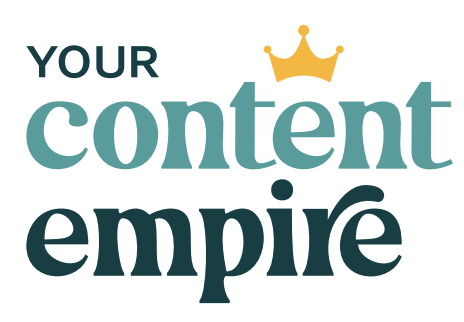Want to start an online business NOW? It’s definitely not too late, even if you think everything's already been done.
Think of it this way: The fact that your business idea already exists in the world is proof there’s a demand for it, and now is your opportunity to bring your unique take on it into the world.
I won't lie and say that starting a business in some ways wasn’t easier in previous years. For one thing, it was cheaper to get in front of more people.
But in other ways, it also used to be a lot harder because there was no paved path for connecting with people through social media. Plus, the easy and automated business tools we enjoy as entrepreneurs today didn’t exist yet- like graphic design templates, CRM software, and automated email providers.
Prefer to watch instead?
In this post, I’m walking you through how to start and grow your business from scratch in one year by walking you through an organized and clear 12-month roadmap.
Month 1: The Set-Up
Okay, you’ve decided to jump in (yay, you!!). Month one is the time to lean into that get-started excitement and ride that momentum as you begin bringing all your ideas together in one plan (a business plan, that is).
Priority #1 – Create a Simple Business Plan
Here are a few things your business plan should include:
- Your business name
- Your website domain and social media handles
- Your legal setup (LLC, sole proprietorship, etc.)
- Your vision and values
- Your first offer
- Your ideal client or customer
- Your positioning and peers in the industry
- Your start-up and anticipated monthly budget
- Your profit plan
- Your time budget (start-up and ideal ongoing)
- Register your business and business name
Priority #2 – Create a simple brand and website
I see so many new business owners go way too far out of pocket creating and designing the “perfect” branding and website. But so much can change in your business within the first year and what you like at the beginning will likely look completely different by the end of the year. So I recommend bootstrapping your branding (you can customize templates) and with so many easy-to-use website tools and templates out there you can DIY a website to get you started easily.
Here’s your simple branding checklist:
- A logo – choose a text-based logo by customizing a template from Canva or CreativeMarket to get you started
- A color palette – 1 main color, 2 accent colors, 1 dark neutral (for text) and 1 light neutral for backgrounds (again you can find something on Canva to customize)
- Fonts – 1 body font (easy to read), 1 header font, 1 accent font (optional)
Then create your simple website:
- Find a template for an easy drag-and-drop builder (like Wix, WordPress Divi, WordPress elementor, LeadPages, SquareSpace, etc.)
- Sign up for a domain and hosting
- Set up your website
- Install your template
- Set up a homepage (begin with a page template and customize)
- Set up an offer page (begin with a page template and customize)
- Set up an about page (begin with a page template and customize)
- Set up a contact page (begin with a page template and customize)
- Set up a blog page (begin with a page template and customize)
Priority #3 – Set Up Accounts
Finally, set up your brand accounts:
- Set up social media accounts with your brand names (Facebook, Instagram, TikTok, Twitter, Pinterest, etc.)
- Set up your email address with your domain
- Set up a free Google Drive account
- Forward your email address to your free Google account (you can also sign up for a Google for Work account but it isn’t needed at this point)
- Sign up for a free MailerLite account and confirm your sending email address
- Install Google analytics on your website
For the most part, these priorities can be completed in a weekend each and can be done fairly affordably. I estimate you’ll spend between $100-$400 on this phase depending on where you live and the templates you choose.
The one thing I do recommend “splurging” on is a P.O. box since you have to have your mailing address at the bottom of your emails and I personally don’t like having my actual address all over the interwebs. It’s up to you!
Month 2: Become Offer-ssed
Month two is all about creating your first offer and getting it ready to sell like hotcakes.
If you already have your offer, great—focus on getting it sale-ready. If you don’t have an offer yet, some easy offers to start with are:
- A simple productized service – design a simple service package that delivers a specific result (i.e. setting up an optimized Pinterest account, creating a lifestyle-specific meal plan) and as you deliver it, create templates and shortcuts to help you deliver a consistent result in less time.
- Ongoing or service packages – design a simple hourly packages (i.e. 5 hours a month of website support, weekly coaching package) that you can systemize and streamline overtime or use as you develop other offers.
- A digital product (courses, kits, templates) – create a small digital product that helps people achieve a specific result for themselves. Check out my digital product series here (part 1 and part 2) on how to come up with a topic and create your first product.
After you dive headfirst into creating your offer and completing it, it’s time to get it ready to sell. At this stage, you’ll want to focus on getting ready to sell by creating your…
- Sales messaging
- Purchase flow
- Salespage or work with me page]
Check out part 3 of my digital product series on how to create an offer docket for your offer messaging, your purchase flow and salespage here.
Month 3: Keep It Sales System Simple
In month three, I recommend putting together a really simple evergreen sales funnel that you can use to start building an interest list and then inviting them to buy or sign up for your offer.
Before you start, map out what your sales process looks like to get an idea of where you’re going to get in front of perfect-fit customers or clients (you might need to do a bit of marketing research), what types of questions do they have or small problems you can solve with a simple PDF freebie and what is your point-of-sale (this will be the call to action for your follow-up emails).
Here’s a mini action plan (although you’ll want to customize this based on the sales system map):
- Creating a simple offer-aligned freebie
- Write 2-3 emails for delivering the freebie and nurturing them with valuable related information
- Write 3-4 sales emails introducing your offer, showcasing how and why it works and inviting them to sign up or buy
The final action step for this month is to write your first blog post. One of the things that makes this approach different from most content marketing advice out there is that we’re starting with viewing your content as long-term assets right from the get-go.
And so your first year will involve writing a new blog post every month to promote and grow your audience. But after you’ve finished writing 12 blog posts, you can technically quit creating new content and just rotate through the posts you’ve already done (unless you’re inspired to create someone or are launching another offer that requires its own content suite).
So here’s your monthly content action plan:
- Write blog post #1. It should be at least 1000 words and help walk your potential customers through how to achieve a goal related to your offer. If you’re finding it difficult to think of a topic, consider what information could prime the reader for your offer.
Month 4: Getting in The Show-Up Habit
No one can buy your offer if they don’t know it exists.
That’s why getting in the habit of showing up and talking about your business and connecting on topics related to your offer online is so important from month four and beyond.
Here’s your action plan for this month:
- Pick 2 social media platforms to start growing: one for engaging with people and having 2-way conversations (some good options are Instagram, Facebook Groups, or LinkedIn depending on where your audience is) and another for getting new eyeballs on your content (good options are Pinterest, TikTok, etc.).
- Publish blog post #1 and promote on each of your two platforms once per week, as well as send a monthly email to your list letting them know about it
- Write and design 26 promo messages and images for your funnel freebie
- Write blog post #2: at least 1000 words walking potential customers through how to solve a problem related to your offer—a small problem I know that perfect-fit potential customers have and need to be solved.
- Have 3 conversations every workday with potential customers and/or peers on your engagement platform
- Measure growth (email list, traffic, offer views, offer purchases) and response at end of the month
Month 5: Solidify Your Show-Up Habit
Last month you set the foundation for showing up, and now it’s time to solidify the habit.
Here’s your action plan for this month:
- Publish blog post #2 and promote it on each of your two platforms once per week, as well as send a monthly email to your list letting them know about it
- Promote your freebie once per week (rotate through your 26 promo messages and image pairs)
- Write and design 26 promo messages and images for your paid offer
- Write blog post #3: at least 1000 words showcasing your products/process/results your process brings people (or yourself)
- Have 3 conversations every workday with potential customers and/or peers on your engagement platform
- Measure growth (email list, traffic, offer views, offer purchases) and response at end of the month
Month 6: Rinse and Repeat – Become a Show-Up Pro
Does the list below look familiar? It should! By now, you’ve formed the habits you need for consistently showing up and in month six you’re ready to become a show-up pro.
Here’s your action plan for this month:
- Publish blog post #3 and promote it on each of your two platforms once per week, as well as send a monthly email to your list letting them know about it
- Promote freebie + paid offer once per week (rotate through your 2 promo message collections)
- Write and design 26 tips related to your paid offer or area of expertise (along with images)
- Write blog post #4: at least 1000 words tackling an objection that potential customers have when it comes to buying your offer (even if they're a perfect fit)
- Have 3 conversations every workday with potential customers and/or peers on your engagement platform
- Measure growth (email list, traffic, offer views, offer purchases) and response at end of the month
Month 7: CEO Review and Pivot
It’s month seven and by now you should be starting to see some momentum. This month, we’re going to take a beat to reflect on what’s working and what needs some shifting.
Here’s your action plan for this month:
- Evaluate your funnel (the freebie, the follow-up emails, the special offer, the landing pages, the messaging). What’s working numbers-wise? What for each of these areas needs some shifting or changes? Make those changes this month.
- Publish blog post #4 and promote it on each of your two platforms once per week, as well as send a monthly email to your list letting them know about it
- Write and design 26 discussion questions related to your area of expertise/ paid offer (paired with images)
- Share your freebie + paid offer + tip once per week (rotate through promo message collections)
- Write blog post #5: at least 1000 words walking potential customers through how to achieve a goal related to your offer. To generate a topic, think: What could you help them achieve to get them ready for your offer?
- Have 3 conversations every workday with potential customers and/or peers on your engagement platform
- Measure growth (email list, traffic, offer views, offer purchases) and response at end of the month
Month 8: Prepping a Live Event
One of the best ways to boost your list and sell your offer is to run a live event and since you have a list now, it’s the perfect time to pull out this strategy.
This month we’re focused on preparing the live event to run the following month. Just like everything we’ve done over the past 7 months, we’re thinking long-term here. The event you design whether it’s a challenge, a webinar, a video series, a workshop, or something else is going to be something you can tweak and run multiple times without having to start from scratch every time.
Here’s your action plan for this month:
- Plan and prepare the content for a live event to get customers for your offer (challenge, webinar, workshop)
- Publish blog post #5 and promote it on each of your two platforms once per week, as well as send a monthly email to your list letting them know about it
- Write and design 13 promo messages and images related to your live event
- Share freebie + paid offer + tip + discussion question once per week (rotate through promo message collections)
- Write blog post #6: at least 1000 words walking potential customers through how to solve a problem related to your offer. This should be a small problem your potential customers are likely facing and want to solve—ideally something that your live event solves
- Have 3 conversations every work day with potential customers and/or peers on your engagement platform
- Measure growth (email list, traffic, offer views, offer purchases) and response at end of the month
Month 9: Run Live Event and Launch
The time has come to run your live event! As much as possible, embrace the fact that not everything is going to run perfectly so just try to remember the primary goal here is connection!
Here’s your action plan for this month:
- Promote and host your live event (week 1-2 of month – promote live event 2-3 times per week, week 3 – host event, week 4 – sell to those who signed up)
- Sell your offer to those who signed up after the event attendees (write 4-5 follow-up emails) and send at least 1 email to your entire list (even if they didn’t sign up for the event to make the offer to them)
- Publish blog post #6 and promote it on each of your two platforms once per week, as well as send a monthly email to your list letting them know about it
- Write and design 26 behind-the-scenes or business stories related to your area of expertise/offer (pair with images)
- Share freebie + paid offer + tip + discussion question once per week (rotate through promo message collections)
- Write blog post #7: at least 1000 words showcasing your offer and how it works (the process/how to use it/etc.)
- Have 3 conversations every work day with potential customers and/or peers on your engagement platform
- Measure growth (email list, traffic, offer views, offer purchases) and response at end of the month
Month 10: CEO Review + Pivot
We’re into the final quarter of year one and I recommend starting with a pulse check on what’s working and what isn’t working.
Here’s your action plan for this month:
- Evaluate your funnel (the freebie, the follow-up emails, the special offer, the landing pages, the messaging). What’s working numbers-wise? What for each of these areas needs some shifting or changes? Make those changes this month.
- Evaluate your launch (the event, the event sign-up pages, the event messaging and promo messages and emails, the follow-up emails, the landing pages, the special offer) and make adjustments
- Publish blog post #7 and promote it on each of your two platforms once per week, as well as send a monthly email to your list letting them know about it ek
- Share freebie + offer + tip + discussion question + story once per week (rotate through promo message collections)
- Write blog post #8: at least 1000 words tackling an objection that potential customers have when it comes to buying your offer (even if they're a perfect fit)
- Have 3 conversations every workday with potential customers and/or peers on your engagement platform
- Measure growth (email list, traffic, offer views, offer purchases) and response at end of the month
Month 11: Invest in Growth
Every month of year one builds on the previous month while also considering future growth in mind. In month 11, you’ll begin investing in your growth in a new way to set yourself up for month 12 and beyond.
Here’s your action plan for this month:
- Choose 1 paid ad platform and start running ads to your funnel opt-in page to grow your list, measure each week and tweak the campaign
- Publish blog post #8 and promote it on each of your two platforms once per week, as well as send a monthly email to your list letting them know about it
- Share freebie + offer + tip + discussion question + story once per week (rotate through promo message collections)
- Write blog post #9: at least 1000 words walking potential customers through how to achieve a goal related to your offer. What could you help them achieve that would get them ready for your offer?
- Have 3 conversations every workday with potential customers and/or peers on your engagement platform
- Measure growth (email list, traffic, offer views, offer purchases) and response at end of the month
Month 12: Re-Launch
We’re in the final month of year one, and it’s time to relaunch your offer. You’ve done the launch before, so much of what’s involved should feel very familiar.
Here’s your action plan for this month:
- Promote and host a live event (week 1-2 promote your live event, week 3 host your live event, week 4 sell your offer to attendees and your entire email list)
- Continue with paid ads to your funnel freebie (measure weekly and make necessary tweaks and adjustments)
- Publish blog post #9 and promote it on each of your two platforms once per week, as well as sending a monthly email to your list letting them know about it
- Share freebie + offer + tip + discussion question + story once per week (rotate through promo message collections)
- Write blog post #10: at least 1000 words walking potential customers through a how to solve a problem related to your offer
- Have 3 conversations every workday with potential customers and/or peers on your engagement platform
- Measure growth (email list, traffic, offer views, offer purchases) and response at end of the month
Year One In Your Built-From-Scratch Business Complete
This monthly checklist is here to help you make the most of it.
Let’s take a zoomed-out view of your first year in business:
- Month 1: Getting Set-Up
- Month 2: Become Offer-ssed
- Month 3: Keep It Sales System Simple
- Month 4: Getting in The Show-Up Habit
- Month 5: Solidify Your Show-Up Habit
- Month 6: Rinse and Repeat – Become a Show-Up Pro
- Month 7: CEO Review and Pivot
- Month 8: Prepping a Live Event
- Month 9: Run Live Event and Launch
- Month 10: CEO Review + Pivot
- Month 11: Invest in Growth
- Month 12: Re-Launch
If it seems simple, it’s because it can be. (I said simple, not easy!)
You can be successful and profitable in year one by making long-term content assets you can rotate through and repurpose the focus pillar of your business.
Ready to Learn the Perfect Content Strategy for New Businesses (Grow Quickly and Start Seeing Results ASAP)?
Get instant access to my E.A.S.E. Content Strategy Workshop where you'll learn the 4 content platforms and strategies to focus on to scale your results and sales from content. Plus you'll get my exclusive EASE Content Planning Spreadsheet for FREE ↓












